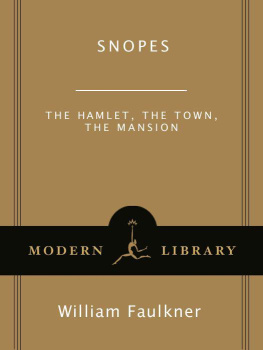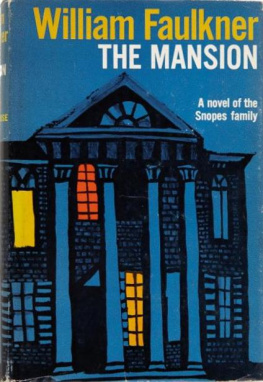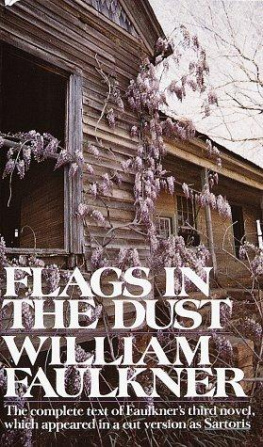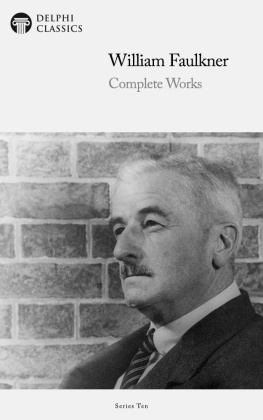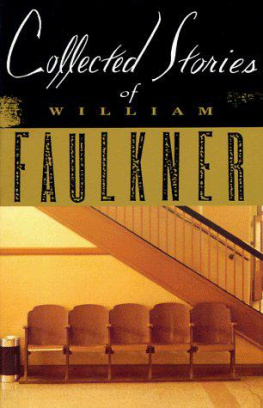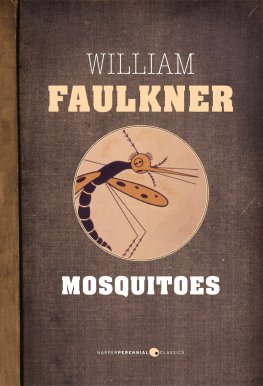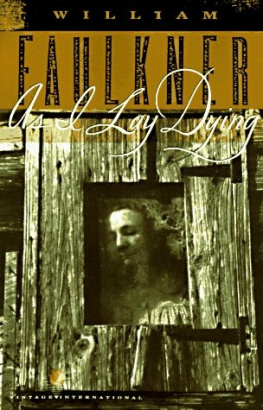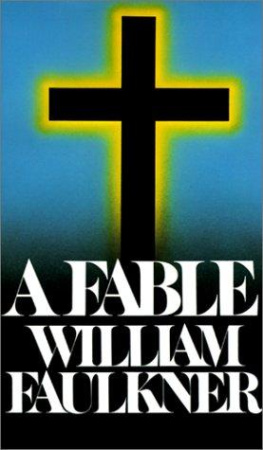William Faulkner - Snopes: The Hamlet, The Town, The Mansion (Modern Library)
Here you can read online William Faulkner - Snopes: The Hamlet, The Town, The Mansion (Modern Library) full text of the book (entire story) in english for free. Download pdf and epub, get meaning, cover and reviews about this ebook. year: 1994, publisher: Modern Library, genre: Detective and thriller. Description of the work, (preface) as well as reviews are available. Best literature library LitArk.com created for fans of good reading and offers a wide selection of genres:
Romance novel
Science fiction
Adventure
Detective
Science
History
Home and family
Prose
Art
Politics
Computer
Non-fiction
Religion
Business
Children
Humor
Choose a favorite category and find really read worthwhile books. Enjoy immersion in the world of imagination, feel the emotions of the characters or learn something new for yourself, make an fascinating discovery.
- Book:Snopes: The Hamlet, The Town, The Mansion (Modern Library)
- Author:
- Publisher:Modern Library
- Genre:
- Year:1994
- Rating:5 / 5
- Favourites:Add to favourites
- Your mark:
- 100
- 1
- 2
- 3
- 4
- 5
Snopes: The Hamlet, The Town, The Mansion (Modern Library): summary, description and annotation
We offer to read an annotation, description, summary or preface (depends on what the author of the book "Snopes: The Hamlet, The Town, The Mansion (Modern Library)" wrote himself). If you haven't found the necessary information about the book — write in the comments, we will try to find it.
William Faulkner: author's other books
Who wrote Snopes: The Hamlet, The Town, The Mansion (Modern Library)? Find out the surname, the name of the author of the book and a list of all author's works by series.
Snopes: The Hamlet, The Town, The Mansion (Modern Library) — read online for free the complete book (whole text) full work
Below is the text of the book, divided by pages. System saving the place of the last page read, allows you to conveniently read the book "Snopes: The Hamlet, The Town, The Mansion (Modern Library)" online for free, without having to search again every time where you left off. Put a bookmark, and you can go to the page where you finished reading at any time.
Font size:
Interval:
Bookmark:


1994 Modern Library Edition
Copyright 1994 by Random House, Inc.
Introduction copyright 1994 by George Garrett
The Hamlet: Copyright 1931 and renewed 1958 by William Faulkner. Copyright 1932 and renewed 1959 by The Curtis Publishing Company. Copyright 1931, 1936, 1940 by Random House, Inc. Copyright renewed 1964 by Estelle Faulkner and Jill Faulkner Summers. Copyright 1964 by Estelle Faulkner and Jill Faulkner Summers.
The Mansion: Copyright 1955, 1959 by William Faulkner. Copyright renewed 1983 and 1987 by Jill Faulkner Summers.
The Town: Copyright 1957 by William Faulkner. Copyright renewed 1985 by Jill Faulkner Summers. Copyright 1957 by The Curtis Publishing Company.
All rights reserved under International and Pan-American Copyright Conventions. Published in the United States by Random House, Inc., New York, and simultaneously in Canada by Random House of Canada Limited, Toronto.
Modern Library and colophon are registered trademarks of Random House, Inc.
The Hamlet, The Mansion, and The Town were all originally published by Random House, Inc.
Portions of The Hamlet were previously published as short stories as follows: Spotted Horses and Fool About a Horse were published in Scribners Magazine; The Hound was published in Harpers Magazine; Lizards in Jamshyds Courtyard was published in The Saturday Evening Post.
A portion of The Mansion was published in Mademoiselle under the title By the People.
Library of Congress Cataloging-in-Publication data is available.
eISBN: 978-0-307-79141-2
Modern Library website address: www.modernlibrary.com
v3.1
A t the living center of the life work of William Faulkner are the novels and stories which deal with Yoknapatawpha County, that imaginary and deeply imagined place, at once based on and derived from his real home country, Lafayette County, Mississippi; but nevertheless independent with its own myths and legends, its own long and shadowy history, its diverse populations, its places much like places he had known and yet altogether his own invention. And at the heart of the fictional accounting of Yoknapatawpha County stands this trilogyThe Hamlet (1940), The Town (1957), and The Mansion (1959)here joined together, as he had always hoped and planned they would be, as one continuous and sequential narrative.
Since constant change, the overwhelming and universal energy of change (for the better and for the worse) is an almost obsessive theme in Faulkners fiction, the story of the Snopes family, from the Civil War until nearly the here and now, is itself constantly changing. There is consistency, to be sure, even though the books were written years apart, interrupted by other books and projects and at otherwise very busy times of his life. Faulkner and his later editorsSaxe Commins for The Town and Albert Erskine for The Mansionmade a serious effort to reduce and to modify, if not to eliminate discrepancies in the individual novels and, indeed, with many other bits and pieces of the Snopes story as it had emerged, early and late, in other novels and in many of the short stories. The authors note at the outset of The Mansion is a kind of credo celebrating his hopes that his entire lifes work is part of a living literature, and since living is motion, and motion is change and alteration and therefore the only alternative to motion is un-motion, stasis, death, there will be found discrepancies and contradictions in the thirty-four-year progress of this particular chronicle.
Even so, Faulkner was perfectly consistent about his aims in the reconciliation of the Snopes material: that consistency should, in fact, work backward from the latest version. Thus a given detail in The Mansion can be taken as the authentic version, but by and large the factual details of the story need not match each other exactly. As he wrote to Albert Erskine: What I am trying to say is, the essential truth of these people and their doings, is the thing; the facts are not too important.
One of the deepest sources of Faulkners art and vision is to be found in his habitual conservation of literary material, a kind of routine recycling that allowed him (and his readers) to review and renew events, characters, places, and thingsthe whole experience of a story from a variety of different angles and points of view. A visionary writer by nature, he was also continually revising, in the context of new work as if freshly remembered, stories he had already told. He was thinking about the Snopes material in the early 1920s, and already by 1926, he was writing some versions of it. Because of the hypnotic impact and signature of his style (styles, plural, would be more accurate), it is easy to miss the wild variety of his work. As an ever-exploring craftsman Faulkner was relentlessly, extravagantly innovative. Among all of his novels no two are constructed in exactly the same manner or told in precisely the same way or from the same points of view. Each is a new artistic adventure, making new and sometimes surprising demands on the reader. (Faulkner is not, not even at his most complex, hard to read, but he insistently invites the reader to a deeper engagement in the experience of the story. To that extent he honors his readers, allowing them to bring as much as they can to the shared experience.) What relates each of the Yoknapatawpha novels, and especially the Snopes trilogy to each other, among other things, is his habit of returning to old stories and reclaiming them for a new look. He invites his reader to remember as well as to encounter events.
The Snopes trilogy, though its forward motion and action, events and plot are riddled with remembering, moves inexorably and chronologically ahead, from the late nineteenth and early twentieth century rural world of Frenchmans Bend in The Hamlet through the first quarter, and then some, of our century in the county seat of Jefferson in The Town, ending there in 1948 in The Mansion. We move from the timeless world of poor farmers and sharecroppers, the Peasants, a world not essentially different from the rural life of all recorded history, into our own times. The world that we know comes alive, comes to be before our eyes. The automobile replaces the mule and wagon. The Memphis airporta hundred driving miles away, not the railroadbecomes the link to the larger, wider world. And yet the past, the world of The Hamlet vividly endures, linked by characters and by stories about them, stories they tell. The past persists and is forever modified by the memories and myths, the speculation and the insatiable curiosity of the central characters, some of whom are, appropriately, the chief tellers of the tale. The Hamlet, though it has many tales told in the quoted words of its chief charactersespecially the wonderful V. K. Ratliff, itinerant salesman of sewing machines and the true custodian and preserver of the countys history and news (which become history and legend soon enough)has an overall, omniscient narrator possessed of a kind of collective voice, a master of many voices and moods. And points of view. There are virtuoso moments as, for example, in the first chapter of Book Three, The Long Summer, the narrator gently, even sympathetically inhabits the consciousness of Ike Snopes, the idiot in love with a cow, and even, for a moment, presents reality from the cows point of view. Mostly the narrator offers a collective point of view (not altogether unlike that of Ratliff) or limits his focus to a deeply sympathetic, yet utterly unsentimental version of the vision of a single character. Sometimes the narrator indulges himself and talks to us in rich mouthfuls of words, as if words were paint to be flung against his canvas. Sometimes this is for fun as when the fart of an old horse, in the opening sentence of Book Three, is described as the rich sonorous organ-tone of its entrails. But the same high style is used to enhance events ad to lift the ordinary to the level of the uncommon. See for yourself how Eula Varner is perceived and presented to us in Book Two.
Font size:
Interval:
Bookmark:
Similar books «Snopes: The Hamlet, The Town, The Mansion (Modern Library)»
Look at similar books to Snopes: The Hamlet, The Town, The Mansion (Modern Library). We have selected literature similar in name and meaning in the hope of providing readers with more options to find new, interesting, not yet read works.
Discussion, reviews of the book Snopes: The Hamlet, The Town, The Mansion (Modern Library) and just readers' own opinions. Leave your comments, write what you think about the work, its meaning or the main characters. Specify what exactly you liked and what you didn't like, and why you think so.

